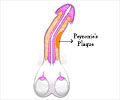A new study has found that what boys lose in the process of circumcision turns out to be the most sensitive parts of the penis.
A new study has found that what boys lose in the process of circumcision turns out to be the most sensitive parts of the penis.
The long-term-health impact of neo-natal circumcision has received little study, while the consequences of circumcision on sexual function in the adult male have received even less attention.But now, a recent study, by M. Sorrels and colleagues from the National Organization of Circumcision Information Resource Center and Michigan State University has plotted the fine-touch pressure thresholds of the adult male penis in circumcised and uncircumcised men and compared the two populations.
Adult male volunteers were assessed with a 19-point Semmes-Weinstein monofilament touch-test to map fine-touch pressure thresholds of the penis. Circumcised and uncircumcised men were compared using mixed models for repeated data, controlling for age, type of underwear worn, time since test ejaculation, ethnicity, country of birth, and level of education.
Analysis of results showed that the glands of the uncircumcised men had considerably lower thresholds than that of circumcised men. There were also noteworthy differences in pressure thresholds by location on the penis. The most sensitive location on the circumcised penis was the circumcision scar on the ventral surface. It was incredible that five locations on the uncircumcised penis that are regularly removed at circumcision had lower pressure thresholds than the ventral scar of the circumcised penis.
This study suggests that the midway region from the external to the internal prepuce is the most sensitive region of the uncircumcised penis and more sensitive than the most sensitive region of the circumcised penis. It appears that circumcision ablates the most sensitive parts of the penis.
The study is published in the April 2007 issue of BJU Int.
Source-ANI
SRM/M











